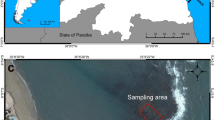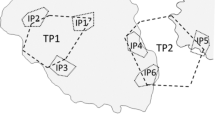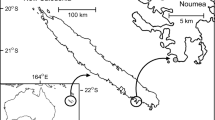Abstract
Neolamprologus moorii, a small herbivorous cichlid of Lake Tanganyika, defends its territory against food competitors. Territory size and territorial defense were compared between two sites at different depths. In the shallow site, more fishes intruded into the territories than in the deep site, owing to the higher density fish population in the former. The territory holders in the shallow site attacked intruders more often, although the ratio of attacks to number of intruders was similar to that of the deep site. The territories in the deep site were larger and contained a greater amount of algae than the shallow site. The larger territory size in the deep site may have resulted from the lower cost of territory defense due to the lower competitor density and from the need to maintain a greater amount of food resources to compensate for lower algal productivity.
Similar content being viewed by others
Literature Cited
Brichard, P. 1989. Cichlids and all the other fishes of Lake Tanganyika. T. F. H. Publications, Hong Kong, 544 pp.
Clifton, K. E. 1991. Subordinate group members act as food-finders within striped parrotfish territories. J. Exp. Mar. Biol. Ecol., 145: 141–148.
Ito, Y., N. Yamamura and M. Shimada. 1992. Animal ecology. Soju Shobo, Tokyo, 507 pp. (In Japanese).
Hixon, M. A. 1980. Food production and competitor density as the determinants of feeding territory size. Am. Nat., 115: 510–530.
Karino, K. 1995. Male-male competition and female mate choice through courtship display in the territorial damselfishStegastes nigricans. Ethology, 100: 126–138.
Karino, K. 1997. Influence of brood size and offspring size on parental investment in a biparental cichlid fish,Neolamprologus moorii. J. Ethol., 15: 39–43.
Kohda, M. 1991. Intra-and interspecific social organization among three herbivorous cichlid fishes in Lake Tanganyika. Japan. J. Ichthyol., 38: 147–163.
Kohda, M. 1997. Interspecific society among herbivorous cichlid fishes. Pages 105–120in H. Kawanabe, M. Hori and M. Nagoshi, eds. Fish communities in Lake Tanganyika, Kyoto University Press, Kyoto.
Kohda, M. and Y. Takemon. 1996. Group foraging by the herbivorous cichlid fish,Petrochromis fasciolatus, in Lake Tanganyika. Ichthyol. Res., 43: 55–63.
Kohda, M. and Y. Yanagisawa. 1992. Vertical distributions of two herbivorous cichlid fishes of the genusTropheus in Lake Tanganyika. Africa. Ecol. Fresh. Fish, 1: 99–103.
Krebs, J. R. and N. B. Davies. 1993. An introduction to behavioural ecology, 3rd ed. Blackwell Scientific Publications, Oxford, 420 pp.
Kuwamura, T. 1987. Distribution of fishes in relation to the depth and substrate at Myako, east-middle coast of Lake Tanganyika. Afr. Stud. Monogr., 7: 1–14.
Kuwamura, T. 1992. Overlapping territories ofPseudosimochromis curvifrons males and other herbivorous cichlid fishes in Lake Tanganyika. Ecol. Res., 7: 43–53.
Kuwamura, T. and K. Karino. 1991. Vertical distribution of fishes on the rocky shore of Kasenga, southern Lake Tanganyika. Ecol. Limnol. Lake Tanganyika, 7: 18–20.
Russ, G. R. 1987. Is rate of removal of algae by grazers reduced inside territories of tropical damselfishes? J. Exp. Mar. Biol. Ecol., 110: 1–17.
Schoener, T. W. 1970. Non-synchronous spatial overlap of lizards in patchy habitats. Ecology, 51: 408–418.
Takamura, K. 1984. Interspecific relationships of Aufwuchs-eating fishes in Lake Tanganyika. Env. Biol. Fish., 10: 225–241.
Takamura, K. 1988. The first measurement of the primary production of epilithic algae in Lake Tanganyika. Physiol. Ecol. Japan, 25: 1–7.
Warner, R. R. 1991. The use of phenotypic plasticity in coral reef fishes as tests of theory in evolutionary ecology. Pages 387–398in P. F. Sale, ed. The ecology of fishes on coral reefs. Academic Press, San Diego.
Whittaker, R. H. and C. W. Fairbanks. 1958. A study of plankton copepod communities in the Columbia Basin, southern Washington. Ecology, 39: 46–65.
Wootton, R. J. 1990. Ecology of teleost fishes. Chapman and Hall, London. 404 pp.
Author information
Authors and Affiliations
About this article
Cite this article
Karino, K. Depth-related differences in territory size and defense in the herbivorous cichlid,neolamprologus moorii, in lake tanganyika. Ichthyological Research 45, 89–94 (1998). https://doi.org/10.1007/BF02678579
Received:
Revised:
Accepted:
Issue Date:
DOI: https://doi.org/10.1007/BF02678579




